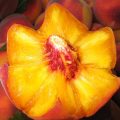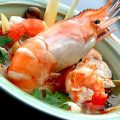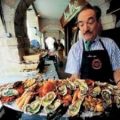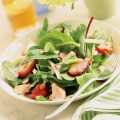Natural starter wine
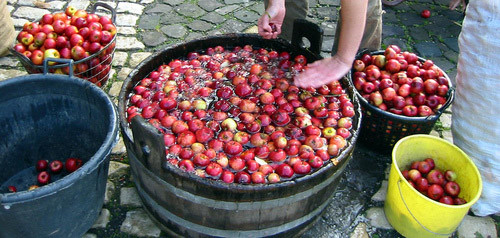 Natural winesBread yeast wines are not suitable. The sourdough is made from wild yeast on the surface of ripe raspberries. Two glasses of unwashed berries are crushed in an enamel (porcelain, glass) dish, placed in a bottle, a glass of chilled boiled water and 1/2 cup of granulated sugar are added. The bottle is shaken, closed with a cotton stopper and placed in a dark place, maintaining the temperature there at 22-24 ° C. After 3-4 days, the juice begins to ferment, it is filtered through cheesecloth and used. The sourdough is prepared once a season and stored for no more than 10 days. Total. To prepare them, you need to have 0.3 liters of sourdough for every 10 liters of wine. If the wine is prepared from late ripening fruits (gooseberries, apples, irga, etc.), then instead of the sourdough for their fermentation, they use the sediment formed during the fermentation of juice more early cultures. The sediment is required to take less - 0.1 liters per 10 LITERS of wine supplied for fermentation, or, as it is commonly called, must.
Natural winesBread yeast wines are not suitable. The sourdough is made from wild yeast on the surface of ripe raspberries. Two glasses of unwashed berries are crushed in an enamel (porcelain, glass) dish, placed in a bottle, a glass of chilled boiled water and 1/2 cup of granulated sugar are added. The bottle is shaken, closed with a cotton stopper and placed in a dark place, maintaining the temperature there at 22-24 ° C. After 3-4 days, the juice begins to ferment, it is filtered through cheesecloth and used. The sourdough is prepared once a season and stored for no more than 10 days. Total. To prepare them, you need to have 0.3 liters of sourdough for every 10 liters of wine. If the wine is prepared from late ripening fruits (gooseberries, apples, irga, etc.), then instead of the sourdough for their fermentation, they use the sediment formed during the fermentation of juice more early cultures. The sediment is required to take less - 0.1 liters per 10 LITERS of wine supplied for fermentation, or, as it is commonly called, must.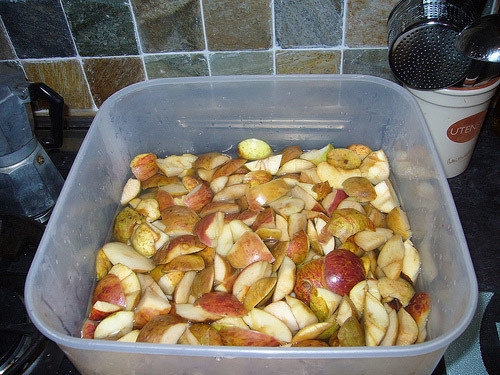 To make wine, fruits and berries must bemature (overripe are unusable) and healthy (rotten, dry, spoiled and moldy are also unusable). Apples (pears, quince) The best varieties of apple wines are obtained from the summer variety Grushovka Moskovskaya and from the autumn-winter varieties Antonovka, Slavyanka, Anis, etc. Winter varieties of apples should be preliminarily subjected to a short maturation of no more than a month. Rowan (Irga) Excellent wines are made from rowan varieties such as Nevezhinskaya, Moravskaya, Kubovaya, Burka, Likernaya, Pomegranate. Chokeberry and Irga, due to their low acidity, are mixed (cunched) with more acidic wine, for example, red wine. Cherries (black, red and white currants) The wines made from these berries are very transparent and beautiful. For aroma, red currant wine is cunched with raspberry, cherry and black currant wine. To reduce the specific strong aroma of black currant, 20 to 50% of red or white currant juice is added to its juice before fermentation. Raspberries Excellent high-quality wines with a strong raspberry aroma are prepared from its red-fruited varieties. Cranberries For wine, it is better to collect snow cranberries, which are perfectly stored frozen, which allows you to make wine from it throughout the winter.
To make wine, fruits and berries must bemature (overripe are unusable) and healthy (rotten, dry, spoiled and moldy are also unusable). Apples (pears, quince) The best varieties of apple wines are obtained from the summer variety Grushovka Moskovskaya and from the autumn-winter varieties Antonovka, Slavyanka, Anis, etc. Winter varieties of apples should be preliminarily subjected to a short maturation of no more than a month. Rowan (Irga) Excellent wines are made from rowan varieties such as Nevezhinskaya, Moravskaya, Kubovaya, Burka, Likernaya, Pomegranate. Chokeberry and Irga, due to their low acidity, are mixed (cunched) with more acidic wine, for example, red wine. Cherries (black, red and white currants) The wines made from these berries are very transparent and beautiful. For aroma, red currant wine is cunched with raspberry, cherry and black currant wine. To reduce the specific strong aroma of black currant, 20 to 50% of red or white currant juice is added to its juice before fermentation. Raspberries Excellent high-quality wines with a strong raspberry aroma are prepared from its red-fruited varieties. Cranberries For wine, it is better to collect snow cranberries, which are perfectly stored frozen, which allows you to make wine from it throughout the winter.
Preparation of raw materials (pulp) for fermentation
Thoroughly sorted, debris,sepals and fruit stems berries and fruits are washed, then they remove the seeds and finely crushed. Apples and other fruits are cut into 5-6 mm pieces with a disc shredder, and the berries are crushed with a wooden pulp in an enamelled bucket. The resulting raw material is immediately processed in preparation for pressing. The crushed raw material (pulp) is poured into an enamelled bucket or into a glass bottle with a wide neck, filling it to 3/4 volume. There also add warmed to 24 ° C water at the rate of 250 grams of water per 1 kg of pulp and the above-mentioned amount of four-day ferment (natural yeast). Then the pulp is stirred, covered with a clean cotton cloth and left to ferment, mixing daily. The temperature in the room should be 20–22 ° С of heat. After 2–3 days, the pulp is pressed using a press in the same way as when receiving dietary juices, or thrown back onto an enameled colander. The small amount of pulp left after the separation of the juice is squeezed out in a bag of rare fabric, twisting it with your hands. Rowan pulp insist before pressing with water for a day at a temperature of 10–12 ° C.
Adding sugar and water to get dessert wines
After squeezing the pulp measure the amountof the resulting wort, subtracting from it the amount of water added to the pulp before and during pressing (sometimes a little water is added to the pulp in the bag). Knowing the output of pure juice without water, you can use the table indicating the amount of water and sugar that you need to add to 1 liter of pure (without water) juice to get a dessert wine.
Fermenting Wort
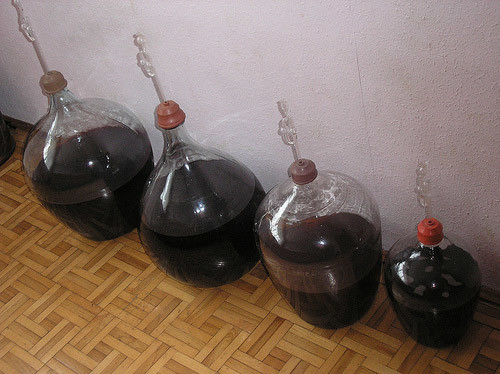 The wort is heated to 22 ° C, poured into glassthe cylinders, filling them with 3/4 of the volume, are closed with a cotton plug and placed in a room with a temperature of 20–22 ° С. Sugar is introduced, as indicated in the table, on the 4th, 7th and 10th days of fermentation, dissolving it in a small amount of cast fermenting wine. To preserve flavor and prevent oxidation, the wort is fermented in two cylinders, one of which is smaller than the other. From a smaller bottle a small amount of wort is poured into a large bottle daily. After the end of rapid fermentation, the large cylinder is topped up to the top, and the contents remaining in the smaller cylinder are poured into an even smaller container to the neck. After this silent fermentation continues for another 3-4 weeks. The end of fermentation is determined by the clarification of wine and the formation of sediment at the bottom, from which the wine should be separated. A bottle of wine put on a stool, and an empty bottle - on the floor. A rubber tube is immersed in the wine so that it is 3 cm above the yeast sediment. On the other side of the pipe, the transparent wine is drawn in with the mouth and, when it begins to flow, they lower the tube into the bottle on the floor. The remaining yeast sediment is poured into a smaller bottle, allowed to stand, and again also drained. The grounds are filtered through a filter cloth. Filtered wine is filled into cylinders up to half a neck, sealed with stoppers or a wooden tongue and placed in a cold (if possible) place for sludge. A month later, the wine is again removed from the sediment. In this form, the wine is called wine material, because it is not yet maintained by condition. To give the wine material fullness of taste and sweetness, sugar is added to it in the following quantities: for liqueur wines - 200 g per 1 liter, for dessert wines - 100–160 g per 1 liter. Sugar is brought in the form of a syrup dissolved in a small amount of cast, slightly warmed wine. Sweet wine is poured into bottles or into bottles up to half a neck, corks are sealed tightly, cork stoppers are filled with tar or wax and pasted on labels. Wines from all grades of currant, from raspberries and cherries are ready to be consumed in 2-3 months, from gooseberries - in six months, and wines from mountain ash acquire the best qualities in a year. They should be stored in fully filled and well corked dishes at a temperature of 15 ° C and below. Amount of sugar in the grapes and red1200490605050Клюква2160680100100100100Cherry cherries (Vladimirskaya, Shpanka) 300190303030Cherry cherries (Lyubskaya and others) 500240505050Malinin700290606060Cultivated apples100100303030Animals 300300505040Stannels and whale yki500200505040Ayva yaponskaya3200830150150150Primechanie: Of this amount of water is necessary to subtract the amount of water introduced into mezgu.Chitayte further:
The wort is heated to 22 ° C, poured into glassthe cylinders, filling them with 3/4 of the volume, are closed with a cotton plug and placed in a room with a temperature of 20–22 ° С. Sugar is introduced, as indicated in the table, on the 4th, 7th and 10th days of fermentation, dissolving it in a small amount of cast fermenting wine. To preserve flavor and prevent oxidation, the wort is fermented in two cylinders, one of which is smaller than the other. From a smaller bottle a small amount of wort is poured into a large bottle daily. After the end of rapid fermentation, the large cylinder is topped up to the top, and the contents remaining in the smaller cylinder are poured into an even smaller container to the neck. After this silent fermentation continues for another 3-4 weeks. The end of fermentation is determined by the clarification of wine and the formation of sediment at the bottom, from which the wine should be separated. A bottle of wine put on a stool, and an empty bottle - on the floor. A rubber tube is immersed in the wine so that it is 3 cm above the yeast sediment. On the other side of the pipe, the transparent wine is drawn in with the mouth and, when it begins to flow, they lower the tube into the bottle on the floor. The remaining yeast sediment is poured into a smaller bottle, allowed to stand, and again also drained. The grounds are filtered through a filter cloth. Filtered wine is filled into cylinders up to half a neck, sealed with stoppers or a wooden tongue and placed in a cold (if possible) place for sludge. A month later, the wine is again removed from the sediment. In this form, the wine is called wine material, because it is not yet maintained by condition. To give the wine material fullness of taste and sweetness, sugar is added to it in the following quantities: for liqueur wines - 200 g per 1 liter, for dessert wines - 100–160 g per 1 liter. Sugar is brought in the form of a syrup dissolved in a small amount of cast, slightly warmed wine. Sweet wine is poured into bottles or into bottles up to half a neck, corks are sealed tightly, cork stoppers are filled with tar or wax and pasted on labels. Wines from all grades of currant, from raspberries and cherries are ready to be consumed in 2-3 months, from gooseberries - in six months, and wines from mountain ash acquire the best qualities in a year. They should be stored in fully filled and well corked dishes at a temperature of 15 ° C and below. Amount of sugar in the grapes and red1200490605050Клюква2160680100100100100Cherry cherries (Vladimirskaya, Shpanka) 300190303030Cherry cherries (Lyubskaya and others) 500240505050Malinin700290606060Cultivated apples100100303030Animals 300300505040Stannels and whale yki500200505040Ayva yaponskaya3200830150150150Primechanie: Of this amount of water is necessary to subtract the amount of water introduced into mezgu.Chitayte further:




